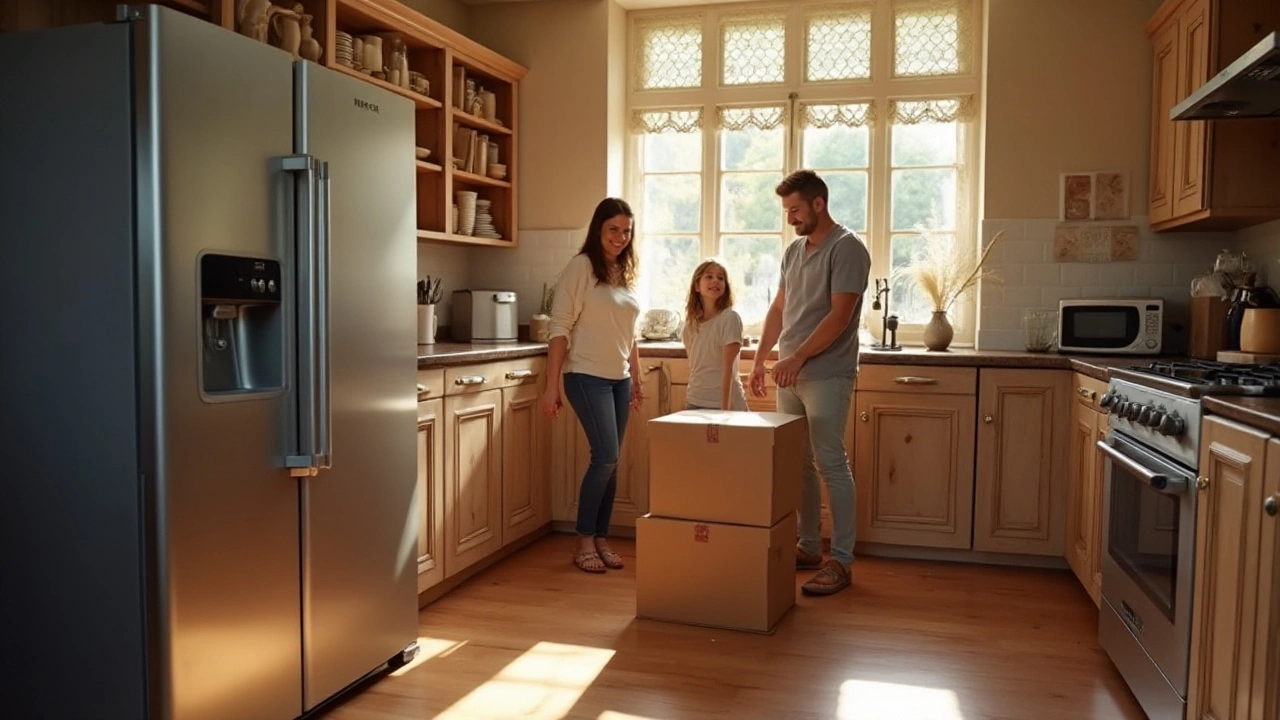
- 11 May 2025
- Gideon Thornton
- 0
If your fridge is starting to act up after seven years, you’re not alone. Plenty of people hit this frustrating crossroads: pay a chunky repair bill or take the plunge on something new. Seven years is right in that middle zone—it’s not brand-new, but it’s not ancient either. So yeah, deciding what to do feels complicated.
Here's what it comes down to: money, hassle, and what you actually get for fixing the thing. Certain repairs, like a busted thermostat or a leaky door seal, actually cost a lot less than you think. But if it’s something like the compressor? That’s where “cheap fix” turns into “big money sink” fast, and suddenly you’re shopping for a brand new fridge even if you didn’t plan to.
Knowing the common issues and what they usually cost to fix at this age saves you guesswork. Plus, a lot has changed with appliances over the last decade—think about energy bills, features, and even how easy it is to get parts. Bottom line: there’s a sweet spot between not giving up too soon and not sinking good money into a lost cause.
- How Long Should a Fridge Even Last?
- What Usually Breaks at 7 Years?
- The True Cost of Repairs Right Now
- Signs Your Fridge Has Seen Better Days
- Upgrade or Repair: What Makes More Sense?
How Long Should a Fridge Even Last?
Fridges aren’t built to last forever, but most people hope for at least ten good years. The numbers back it up—according to appliance industry groups, the average fridge lasts between 10 and 13 years. That said, seven years is actually just past the halfway point for most models.
The type of fridge matters too. Top-freezers are known to outlast side-by-sides and those fancy French door models. Some of the budget options might not even make it past eight or nine years if they’re used hard.
But regular use, where you open and close the door constantly day after day, can lower that expectancy. Do you have pets? More hair and dust means your coils work harder, so parts wear out quicker.
There are a few things that make your fridge’s lifespan shorter or longer:
- How well you clean the coils and keep the door seals tight
- If your home has steady power (surge-prone homes kill appliances faster)
- How packed your fridge stays—overstuffed means more wear on the motor
- If you actually follow those little maintenance tips in the manual
So is a fridge repair even worth it at seven years? If it’s been reliable and you’ve taken care of it, there’s still a decent chunk of life left. But if it’s already had constant problems, starting to break down now might be a warning sign that it’s on the way out.
What Usually Breaks at 7 Years?
Seven years is kind of a tipping point for a lot of major fridge parts. By now, some things have been running long enough to wear out, even if you’ve kept up with simple maintenance. Here’s a rundown of what usually goes wrong in a 7-year-old fridge and what that means for your next move.
- Compressor: The heart of the cooling system. If you hear loud clicking or buzzing that won’t quit, it’s probably this guy. A new compressor is pricey—often half the cost of a new fridge.
- Thermostat or Control Board: If you’re getting random temps or the fridge sometimes just shuts off, the thermostat or the brains (the control board) can be the culprit. These parts act up as years and electrical surges add up.
- Door Seals (Gaskets): If your door’s not closing tight, cold air is leaking and your food’s at risk. Seals lose their flexibility and get grimy over the years, making your fridge work extra hard.
- Evaporator Fan: Weird noises and uneven cooling? The fan may be wearing out. Luckily, this repair is usually cheaper than the rest.
- Ice Maker: These things clog, freeze, or just quit working after years of use. If you use yours a ton, plan for problems around this time.
To see how common fixes shake out, check this quick data snapshot from appliance repair pros in the U.S.:
| Part | Most Common Symptoms | Average Repair Cost (USD) |
|---|---|---|
| Compressor | No cooling, loud clicking | $350 - $700 |
| Thermostat/Control Board | Random temps, fridge won't start | $200 - $400 |
| Door Gaskets | Poor seal, warm spots | $75 - $200 |
| Evaporator Fan | Noisy, uneven cooling | $120 - $250 |
| Ice Maker | No ice, leaks, jams | $100 - $250 |
Your fridge repair decision mostly comes down to what breaks and how much it costs vs. a newer, more efficient model. If you’re hearing some weird noises or noticing food spoiling faster, it’s probably one of the parts above calling for attention.

The True Cost of Repairs Right Now
Here’s where things get real. Fixing a 7 year old fridge isn’t just a matter of calling a repair guy and handing over pocket change. Some repairs cost much less than expected, while others will have you thinking about why you didn’t just use a cooler and buy ice instead.
Most folks call in help for things like thermostats, fans, door seals, or ice maker issues. Check out what people in the U.S. are actually paying right now for common fixes:
| Repair Type | Average Cost in 2025 (USD) |
|---|---|
| Thermostat Replacement | $180 - $250 |
| Evaporator Fan Motor | $150 - $300 |
| Compressor Replacement | $500 - $900 |
| Ice Maker Repair | $130 - $300 |
| Door Seal/Gasket | $60 - $180 |
If you see a high price on the list—yeah, compressor failures are where your budget starts to cry. That one repair often costs half the price of a new fridge, or even more if your model is fancy. A simple seal or fan fix usually makes sense if the fridge is still running strong otherwise.
Don’t forget hidden costs either. Some service companies charge a $75 to $150 fee just to show up at your house, even if you skip the repair. Plus, supply chain hiccups are making some parts harder and more expensive to find for older models. If your fridge is a brand that’s not huge in the market anymore, you might even wait weeks for a component.
When thinking about fridge repair, always weigh the total price against how much life you actually expect to get out of your appliance. If you’re quoted a repair that’s more than 40-50% the cost of a new fridge (which averages about $1,200 for a basic model in 2025), take a second to really consider if it’s worth the cash.
Signs Your Fridge Has Seen Better Days
Some clues are way more obvious than others. The trick is spotting them early so you avoid a full-on food disaster or a wallet-busting electric bill. For a 7 year old fridge, these problems pop up a lot:
- Food isn’t staying cold: If milk is going bad quickly or leftovers just don’t feel cold enough, your fridge might be struggling. This usually points to failing parts like the compressor or thermostat.
- Weird noises: Buzzing, clicking, or loud humming aren't just annoying—they're classic signs the motor or fan is on its last legs.
- Too much frost: Notice ice building up in the freezer or along fridge walls? That’s bad circulation or a busted defrost system. You should barely see any frost these days.
- Puddles or leaks: A fridge should never leave water on the floor. If you see it, you could be dealing with a clogged defrost drain, cracked water line (on ice-maker models), or broken seals.
- Sky-high energy bills: Noticed your power bill creeping up a lot? Old fridges can become huge energy hogs as they wear out—even if they look fine on the outside.
Here’s a quick look at how these problems can hit your wallet or daily routine:
| Problem | What It Means | Typical Impact |
|---|---|---|
| Food not cold | Thermostat/compressor fails | Wastes groceries, possible repair $300-$600 |
| Constant noise | Fan or motor failing | Annoyance, future breakdown |
| Puddles/leaks | Seal/drain issue | Slip risk, mold, minor repair $100-$200 |
| Lots of frost | Defrost system broken | Unit runs nonstop, higher bills |
| Power spikes | Worn out fridge parts | Monthly utility cost jumps $10-$25 |
If you’re ticking off more than one of these boxes, especially with that sudden hike in your energy bill, it might not be worth fixing up anymore. Keeping a close eye on these warning signs now can save you from a bigger headache later.

Upgrade or Repair: What Makes More Sense?
This is the decision everyone hates. Should you cough up for a repair or just cut your losses? After about seven years, most refrigerators have lost some efficiency. Energy Star estimates a typical fridge lasts 10 to 15 years, but performance (and repair needs) ramp up around year seven or eight. So how do you figure out if you should keep fixing or replace it?
Let’s be blunt: if the repair will cost more than half the price of a new fridge, it rarely makes sense. Say your fridge repair runs $500, but a new, energy-efficient replacement is $1,200? Go for the upgrade. You’ll save on electricity and might even get better features like digital controls or adjustable shelving.
- Compressor, evaporator coil, or sealed system failures: These repairs often run $700–$1,000. That’s usually not worth it.
- Fans, thermostats, door seals, water valves: These often cost between $100–$300. If the rest of the fridge is solid, repairing makes sense.
Plus, there’s the hidden cost: an older, inefficient fridge could eat up $50–$100 more in energy every year compared to a newer model. That adds up!
| Repair Type | Avg. Cost (USD) | DIY Possible? |
|---|---|---|
| Compressor replacement | $700–$1,000 | No |
| Evaporator fan | $150–$300 | Yes |
| Thermostat | $100–$250 | Yes |
| Door seal | $50–$150 | Yes |
| Ice maker | $100–$350 | Yes |
Love your fridge or it still looks and runs like new? Then minor repairs might squeeze a few more years out of it. But if you’re on your second big repair in a year or it’s making odd noises, leaks, or struggles to stay cold, an upgrade pays off. And since new fridges can cut energy use by up to 40%, lower bills make a real difference.




